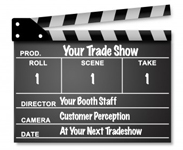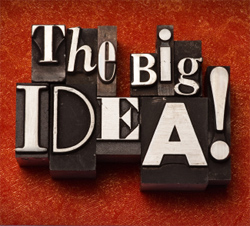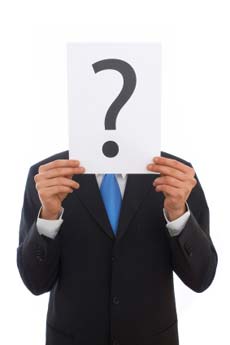Trade Show, Show Business: Put the “Show” Into Your Exhibit
When you are putting together a tradeshow exhibit, think about it as theater. You need to attract an audience, capture their imagination, and leave a memorable impression. To do that you need to set the stage and build an atmosphere that will draw people into your booth – bring them into your show.
 You need a great script and the best actors you can find
You need a great script and the best actors you can find
If you want great reviews, then you need to start with a great script. Then you need “actors” who can bring that script to life and who can improvise. Give them the perfect costumes and a stage setting that builds on your brand story, and your exhibit will draw prospects right into your show.
Don’t be afraid to be dramatic!
Some of the most imaginative, most successful trade show exhibits are done by companies who offer intrinsically boring products and services. They do not have the luxury of relying on people being interested in what they are selling, so they often work much harder to add entertainment value to their exhibit. These are some of the booths with the most creative themes and visual drama.
Go a bit outside the box, push the boundaries. Trade show attendees want to see something new and exciting. Just remember to stay consistent with your brand position and brand values.
Lights, camera, action
Well, OK – lights and action! One way to create visual interest is with your lighting design. Work with your designer to build a lighting concept that presents your ideas in a clear way to focus on your company’s competitive advantages. Take it to the next level by using lighting to do more than spotlight your product, use it to create a spotlighted stage for your booth team.
Make your show a tough act to follow
If you create a real show, your exhibit will be the one that people remember when they walk into your competitors’ booth and when they return to their day-to-day business after the show. It will be the one that they talk to their co-workers and associates about. And, perhaps best of all, it will be one of the exhibits that gets press extending your trade show marketing reach.
Staff Your Trade Show Exhibit to Make the Sale!
You’ve done everything brilliantly. Your new trade show exhibit has arrived and is set up. Your product displays are stunning. Your agency put together collateral that will impress your prospects. Everything is set for the show opening — or is it?
 The majority of buyers only attend one or two trade shows a year, and they come to the show planning to make buying decisions. Plan ahead so you have the right team to close the sale.
The majority of buyers only attend one or two trade shows a year, and they come to the show planning to make buying decisions. Plan ahead so you have the right team to close the sale.
Are you properly staffed?
Most people are aware that having a well-trained trade show exhibit staff is one of the keys to trade show success. But it is just as important to be properly staffed.
Make sure you have the right staffing mix at the show. What functions need to be represented? Do you need technical staff or product specialists to support your sales team? Augment your trade show exhibit team with home office staff who are on call and available to answer questions and provide information to key prospects.
Do you have enough staff to cover the booth?
Even in a small trade show exhibit, it is ideal to have at least two people at your booth all the times so that one person is free to leave the booth and interact with attendees as they are walking by. If you are trapped in your booth waiting for them to come to your trade show exhibit, you will miss key prospects.
Make sure your team maximizes downtime
There is a lot of downtime at a trade show. Some experts estimate that as much as 90% of the time exhibitors spend at a trade show is wasted. Organize lead follow-up activities so that they can be done from the exhibit floor during these idle periods. Send out follow-up emails to prospects. Gather information to answer questions from prospects and get these answers to prospects before the show ends. Meet with the press to generate some proactive PR for your company. Have your team communicate trade show news to key prospects who could not attend the show from the trade show floor.
The right team is the essential element
Put the right team in a great trade show exhibit. Give them the training and tools they need to succeed and you will increase your trade show sales.
Top Tactics to Make Your Trade Show Booth Stand Out
Every industry has its norms. At a medical industry show, the show floor will resemble a tranquil sea of blues and whites, colors that convey cleanliness and reliability. At technology industry shows you’ll see lots of bright colors, bold graphics and eye-popping presentations on flat-screen monitors. While every industry has its norm, the reality is that in order to make your booth get noticed by attendees, the last thing you want to do is to blend in with competing booths.
 So how do you differentiate your exhibit so attendees will be captivated long enough for your booth staff to engage them and deliver your company’s marketing message? In order to successfully achieve your company’s trade show objectives, whether that is generating sales leads or educating a new market about your products or services, the first step is to garner the attention of prospective customers.
So how do you differentiate your exhibit so attendees will be captivated long enough for your booth staff to engage them and deliver your company’s marketing message? In order to successfully achieve your company’s trade show objectives, whether that is generating sales leads or educating a new market about your products or services, the first step is to garner the attention of prospective customers.
Many companies exhibiting at trade shows make the classic mistake of trying to fit in with other exhibitors. Perhaps it’s your company’s first foray into a particular market or event. You want your company to look like it can play in the same sandbox with other big players in the market. The problem is fitting in isn’t going to help your company stand out amidst its competitors.
Here are a few ways in which you can differentiate your company’s exhibit:
Color: Avoid the standard color palette of the industry. Choosing a unique color scheme for your booth is a simple way to visually set your booth apart from other booths. Be careful, however, and do your research before picking a color scheme. Different colors convey certain messages that might not align with your trade show objectives or your marketing message.
Structure: Be creative here, and don’t settle for a standard exhibit configuration. If your competition typically uses a booth layout with formal meeting areas/rooms, go for a casual lounge feel instead. If competing booths are very geometric and angular, go for a free-flowing, airy feel with a fabric structure featuring organic shapes and soft, curvy lines.
Lighting: One way to breathe new life into an older exhibit is to enhance or change up the lighting scheme. Be creative here as well. Colored lights can add pizzazz and be a real attention-getter. Soft lighting can create a calm, intimate setting.
Product Displays: Don’t overcrowd surfaces with product displays. Again, take note of what your competitors are doing. Use creativity to highlight your products in a way your competitors aren’t. Again, the purpose is to get your booth to stand out so attendees will pause long enough to notice your products and marketing message.
Booth staff: It’s important to put together a “front line” offense when it comes to your booth staff. Don’t staff your booth with temp workers or new employees. Bring out your “big guns,” which typically means your product development folks who can speak at great length—not just about your products, but those of your competitor’s and industry pain points as well.
Trade Show Exhibit Design: It pays to “Think Big”
If you want a Trade Show exhibit that is memorable and persuasively communicates your brand, keep it focused on one overarching idea. Think Big. Create a “Big Idea”.
 When a prospect walks into a Trade Show they are confronted with hundreds – even thousands of different marketing messages. If you are lucky, your company will have 15, maybe even 30-seconds to capture that prospect’s attention.
When a prospect walks into a Trade Show they are confronted with hundreds – even thousands of different marketing messages. If you are lucky, your company will have 15, maybe even 30-seconds to capture that prospect’s attention.
The less you try to say, the more people remember.
One way to break through the competitive clutter is to have a single-minded message – a simple statement that sums up the most important thing you can say about your company that will convince a prospect to consider buying your product – and then to communicate this message with creative that is attention-getting and memorable. This is often referred to as a “Big Idea”.
What if your company doesn’t have a single-minded message?
Sometimes the answer is already part of your company’s marketing program. For most companies, particularly B2B firms, I have found that there is no single-minded message in the advertising and marketing communications. Usually, there is a well thought out graphics standard, a nice logo and tagline, and some positioning and benefits copy on collateral and the company’s website.
If your company doesn’t have a single-minded message, develop it. Look for a key insight about your brand. Start with your customers’ buying behavior to discover one significant reason why customers buy – or why they don’t buy – from your company.
Then answer this “simple” question, “What is the one thing we want to say to our target customer to convince them to buy from us?”
Ask the people who work with you the question. Sometimes the head of Sales and Marketing can answer the question immediately. But if no one can answer the question, answer these three questions:
- Why do you need a big idea?
- What is the problem you are trying to solve?
- Why does the problem exist?
Then sum up the answers into a one sentence response that answers the question, “What is the one thing we want to say to our target customer to convince them to buy from us?”
How can you come up with a “Big Idea”?
Once you have a single-minded message, you can start to work with your creative team to create a “Big Idea” that powerfully communicates the message. A good place to start is to select an exhibit marketing support firm that has the capability of working with you to craft this “Big Idea” and to align every aspect of your trade show effort to support the “Big Idea”.
Communicate this “Big Idea” in every element of your trade show exhibit – from the graphics and exhibit to the people who are staffing your booth to promotional materials – make sure that everything is building an attention-getting, memorable message.
You can incorporate your “Big Idea” into all the elements of your trade show program:
- Exhibit theme
- Live presentations
- Traffic building attractions
- Booth staff
- Pre-show promotion
- Lead response and follow-up
Does your company have a single-minded message? Has your exhibit marketing support firm delivered a big idea for your company?
Staff Your Trade Show Exhibit to Win!
 Anyone who has attended a trade show can tell you that the best booth, in the best location, with the best promotion, may not get the sale if you do not put together the right team to represent your company.
Anyone who has attended a trade show can tell you that the best booth, in the best location, with the best promotion, may not get the sale if you do not put together the right team to represent your company.
Overall, you are looking for people who are fun to be with and who can help bring your booth to life. Here is a checklist of critical factors to consider when selecting your team.
- Make sure you have the right number of people to staff the booth. It depends on the type of show, your business sector and the type of promotional campaign you plan. A good rule of thumb is one person for every 50 square feet of booth space, including break coverage.
- Make sure that the people staffing your booth have an appearance that is consistent with your brand and trade show campaign.
- Look for people who are naturally friendly and outgoing, and who smile. You want people who are eager to meet attendees.
- Select people who are good listeners and who know how to ask open-ended questions that encourage prospects to talk about their needs.
- Choose team members who know your business sector or who can be quickly trained to knowledgeably answer questions. It is best to select people who know your product, your company and its capabilities, and who know the competition.
- Think about attire and set a dress code. Don’t leave this critical element to chance. Make sure your entire team is willing to follow the dress code.
Once you have selected your team, make sure they have the tools they need and are properly trained to represent your company, qualify leads and secure sales.
Putting your Best Face Forward: How to Staff your Trade Show Booth
You can spend lots of money creating an eye-grabbing, elaborate trade show exhibit, but lose potential customers if your booth personnel are not well trained and prepared. Make it an essential part of your pre-show strategy, right along with pre-event marketing and demo preparations. Keep in mind that these people will leave a lasting impression, good or bad, on your attendees and potential customers when they leave your booth, so pick the best and brightest to represent your organization.
Here are a few more tips on how you can ensure that everyone in your trade show staff is show-ready:
Make sure they are well versed. This is particularly important when using temp workers. These people need to know detailed background about your company, its mission, goal, target audience, products or services, as well as your sales and marketing message.
Practice makes perfect. Establish a pre-show training session and conduct them before every show. Prepare a list of objectives and make sure everyone is aware of their role. For example, some people might be assigned official greeters, while others might be reserved for fielding more detailed technical questions.
 Choose friendly folk. This might seem obvious, but the more outgoing and friendly a person is, the better they will be at engaging prospects.
Choose friendly folk. This might seem obvious, but the more outgoing and friendly a person is, the better they will be at engaging prospects.
Stick to the script. Training booth personnel should include a well-practiced script that includes a quick introduction of themselves, a one-minute overview of your company and its products; a few questions to qualify the attendee as a potential prospect; and a request for contact info for effective follow-up after the event.
Dress the part. Make sure that booth staff understands what is expected of them in terms of how to dress, proper etiquette (no gum chewing, eating, etc.), the importance of arriving early and being prepared, and how long they are expected to be on duty.
Don’t overstaff. It’s human nature to avoid excessively crowded spaces and nothing is more intimidating then walking into a booth and being besieged by a throng of over-eager salespeople. Proper staffing will depend upon the size of the actual booth.
Put sales staff on the front line. Even if you rely on temporary help at trade shows, it’s vital to have salespeople in the mix and preferably taking the lead in greeting visitors and doing demos.
Listen more, talk less. Companies can learn more about potential customers and how they might be able to help them by taking the time to listen to their needs, pain points, issues, etc. Booth staff should adhere to the 80/20 principle: listen 80% and talk only 20%.
Tradeshow Booth Staffing Tips
Hiring tradeshow talent and booth staff can provide an exhibitor much better returns on investment than in years past, providing that one understands the need, and seeks the most qualified candidate(s) to fill that need.
Pre-Qualify Prospects: Trade Show Talent Acts as an Ambassador for Your Booth
Browse the internet for convention and tradeshow models, and you’ll find that there are hundreds of agencies providing this type of service. With so much to choose from, where to begin? First, prioritize your needs as an exhibitor. The early days of car show models & booth babes have expanded into tradeshow talent that can not only greet attendees but also demonstrate products and engage attendees in conversation. When considering hiring staff, be sure to consider what the role of this hired talent will be.
When Hiring Talent for your Tradeshow Booth, Find a Reputable Agency
 If you expect superior communication skills, good eye contact, and a witty personality, then you shouldn’t just go online and start looking for price quotes. You’ll want to start by finding a reputable agency, preferably one recommended by a display house, that has numerous testimonials and references. Furthermore, you will want to outline, in writing, precisely what you will expect from your hired tradeshow staff. They are, after all, an extension of your sales staff, as the CMT agency states on it’s website “More important than just being attractive, they know and exemplify the fact that being outgoing, friendly, engaging and professional are what matter most on the tradeshow floor.”
If you expect superior communication skills, good eye contact, and a witty personality, then you shouldn’t just go online and start looking for price quotes. You’ll want to start by finding a reputable agency, preferably one recommended by a display house, that has numerous testimonials and references. Furthermore, you will want to outline, in writing, precisely what you will expect from your hired tradeshow staff. They are, after all, an extension of your sales staff, as the CMT agency states on it’s website “More important than just being attractive, they know and exemplify the fact that being outgoing, friendly, engaging and professional are what matter most on the tradeshow floor.”
Base your search for hired staff on your written outline of criteria. Speak to the agency about the qualifications and experience of each booth model. Ask the agency the tough questions, don’t be afraid to shop around. You will find that some agencies book superior talent, far beyond what might be considered standard or acceptable, including interpreters, product presenters, costume characters or entertainers. Find some talent with more than just a pretty smile. You might find that a well-qualified presenter just happens to be available during your show days, and needs the work. Why settle for a bikini model when you can have an excellent ambassador in your booth?
Include Tradeshow Booth Talent in Your Booth Staff Training
Before the show, outline a plan for your hired staffers. Share it with them well in advance so they may ask questions and get clarification. Expect them to show up well before the show starts each day, and have a briefing about expectations and or goals. INCLUDE THEM IN YOUR BOOTH STAFF TRAINING! You will want to emphasize the importance of pre-qualifying prospects, a major part of booth staff training. At the end of the day, have a wrap-up meeting, and again, include them with your staff. You are, after all, paying a premium – so why not demand a little more? If you make your staffing choices well, you can not only increase traffic and lead generation, you will also ratchet up tradeshow ROI.
The Perfect Trade Show Booth Requires a Great Team
 Have you ever been to a trade show and see a great exhibit, but no one is there to greet you? Or you start to approach a booth and see a couple disengaged people slumped in chairs, hiding? Or the booth staff is occupied talking on their cell phones and texting? My bet is that you just passed this exhibit by.
Have you ever been to a trade show and see a great exhibit, but no one is there to greet you? Or you start to approach a booth and see a couple disengaged people slumped in chairs, hiding? Or the booth staff is occupied talking on their cell phones and texting? My bet is that you just passed this exhibit by.
The team who staffs your booth is a critical part of a successful event. Make sure they are properly trained, motivated and equipped to succeed.
- Select people to staff the booth who have the right attitude. You need people who are open and approachable, who can smile when their feet hurt, and who really enjoy meeting new people.
- Train your team so that they know the main messages you want to communicate at the show, and can answer most customer questions. Knowledgeable people in your booth will generate higher quality leads and more sales.
- If product demonstrations or structured sales presentations are part of the exhibit, make sure that every member of your team is at least loosely scripted and has rehearsed.
- If you have any special promotions, make sure the booth staff understands all the details and deal terms.
- Have a formal staff schedule and base the staff rotation on the expected trade show volume at given time. Develop a contingency plan to adjust staffing if needed.
- Establish a dress code which is consistent with your company’s or organization’s brand and the booth theme.
- Formalize the lead qualification process and make sure everyone uses the same criteria to qualify prospects and record contact information.
What do you think is the most important factor when selecting someone to staff your trade show booth: product knowledge or positive attitude?
Take the Lead: How to Leverage Tradeshow Prospects
The number-one priority of nearly every tradeshow exhibitor is to leave that event with a high number of qualified leads that with proper follow-up can be converted into future customers. Leads replenish the sales pipeline, bring in new customers, and generate sales revenue. Efforts to do this must start by developing a strategy for gathering and qualifying leads in the early planning stages for an event.
Assess an attendee’s interest in addition to obtaining relevant information
 Representatives of your company who will be working in your booth need to know in advance what information they need to gather from each attendee to determine whether that person has the potential to buy your product or service. In order to determine that, the booth personnel need to assess an attendee’s interest in addition to obtaining other relevant information on their specific needs, budget requirements, and timing for a potential purchase.
Representatives of your company who will be working in your booth need to know in advance what information they need to gather from each attendee to determine whether that person has the potential to buy your product or service. In order to determine that, the booth personnel need to assess an attendee’s interest in addition to obtaining other relevant information on their specific needs, budget requirements, and timing for a potential purchase.
Select an automated tracking system
Automated tracking systems can also facilitate the process of capturing prospects’ contact information, though they might lack the personal contact that conveys that your company is truly interested in their needs and how it might be able to help them meet those needs. Automated tracking systems can be rented and work by electronically capturing data by having booth visitors swipe their badges as they enter the booth.
These systems vary, so do your research. Be sure the system’s output provides all the data you require for post-show marketing initiatives. Educate yourself on which equipment and software will best achieve your objectives. If automated systems can’t provide all the information you need, you might be better off opting for manual means of tracking tradeshow leads.
Know as much as possible about each sales prospect
More is better when it comes to information about potential leads. By knowing as much as possible about a sales prospect, you can devise a more effective follow-up strategy that more closely aligned with the specific needs of each person. In addition, detailed information enables you to evaluate the potential of each lead so you can prioritize your efforts. With detailed lead information, you can fine-tune your post-show marketing efforts and focus on the prospects you can most likely to convert to future customers.
Follow-up after the show is also critically important. Be sure and have booth personnel make note of how each prospect would prefer to be contacted by a company representative. After the show, contact prospects by phone, mail, or email. Be sure and follow up—either by a personal call or written contact—within a week of the show. After the show, track leads to determine each show’s effectiveness and expand efforts in shows with the best return on investment (ROI).
Who Makes the Best Trade Show Booth Staff?
What to Consider When Determining the Best Staff for your Trade Show Booth
It may not always be the best idea to have your top salespeople staff your tradeshow display. There are several reasons to consider others to staff your booth.
- Most salespeople are born and bred to “close sales” and very few sales can actually be closed at a trade show.
- Salespeople will most likely have a number of current customers at the show. Tradeshow marketing objectives are, for the most part, based on gathering leads. It may be better to allow your sales staff the freedom to spend time with their customers and use others to staff your booth.
- Salespeople are typically very hard to manage. A well trained, disciplined approach to booth staffing may produce better results.
 So if not salespeople, then who does make the best booth staff? There is no one correct answer to this question. I believe that each company needs to look at the goals and objectives that they have established for each show and staff accordingly. Each tradeshow exhibit, large or small, should have a preplanned basic procedure for handling visitors that is designed to properly communicate your chosen message, answer any questions and record lead information for follow-up.
So if not salespeople, then who does make the best booth staff? There is no one correct answer to this question. I believe that each company needs to look at the goals and objectives that they have established for each show and staff accordingly. Each tradeshow exhibit, large or small, should have a preplanned basic procedure for handling visitors that is designed to properly communicate your chosen message, answer any questions and record lead information for follow-up.
There should be people assigned to greeting and qualifying visitors to the booth. This role should be filled by a person who is approachable, pleasant, smiling, energetic and a good communicator. Choose people to fill this role very carefully, as they will make that first and lasting impression on your prospects. Once a prospect has been qualified, this person should also be capable of delivering a brief presentation on your company.
As conversation with the prospect continues into more depth, there must also be someone in the booth that is very product or service knowledgeable. This could be a technical person, manager, or inside sales representative. Ideally, with the help of your staff, the prospect gets the information they need and leaves your booth with a positive impression of your company.
Think about your goals for the show and make sure to select and send the staff that gives you the best shot at not only meeting your goals, but exceeding them.
Archives
- July 2021
- June 2021
- May 2021
- April 2021
- October 2018
- September 2018
- August 2018
- July 2018
- June 2018
- May 2018
- April 2018
- March 2018
- February 2018
- January 2018
- December 2017
- November 2017
- October 2017
- September 2017
- August 2017
- July 2017
- June 2017
- May 2017
- April 2017
- March 2017
- February 2017
- January 2017
- December 2016
- November 2016
- October 2016
- September 2016
- August 2016
- July 2016
- June 2016
- May 2016
- April 2016
- March 2016
